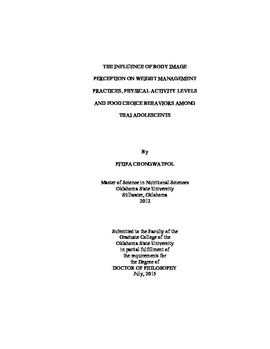| dc.description.abstract | Body dissatisfaction has not been directly observed in Thai adolescents and little information about weight management practices among Thais is available. This research included 2,082 male and female adolescent participants and measured 2 aspects of body dissatisfaction: adiposity (for males and females) and muscularity (for males) dissatisfaction. Four manuscripts were prepared from the data obtained. First, adiposity dissatisfaction, physical activity, food choices, and weight management practices of males and females who attended single- and mixed gender schools were compared. The second study categorized both male and female participants into 3 groups by adiposity dissatisfaction (no dissatisfaction, wanted thinner or bigger figures), and compared physical activity, food choices, and weight management practices. The third manuscript classified male participants into 3 groups by their muscularity dissatisfaction (no dissatisfaction, wanted to increase or decrease muscularity) and compared physical activity, food choices, and weight management practices. Lastly, predictors of body dissatisfaction and number of weight management practices were evaluated. Over 80% of the participants reported dissatisfaction with their current body. Females and males had similar levels of body dissatisfaction, but a majority of females wanted to be thinner, while males wanted to be either smaller or bigger. Gender and school environment impacted food choices, physical activity, and number of weight management practices used. Even though some male participants did not report muscularity dissatisfaction, most tried to change their weight, body fat, and muscle. The participants who wanted to increase muscularity also tried to lose body weight and fat. Overall, food choices and physical activity of the participants with body dissatisfaction did not differ from the participants who did not report body dissatisfaction, but different weight management practices were used to reach their desired bodies. The most frequently reported weight management practices were exercise and increased fruit and vegetable consumption. Few participants reported engaging in unhealthy weight management practices. Among Thai adolescents, risk factors of body dissatisfaction were gender, fathers' education, household income, BMI, and comments from primary caregivers. Use of more weight management practices was predicted by body dissatisfaction, gender, mothers' education, BMI, food choices, physical activity and sociocultural factors. | |
